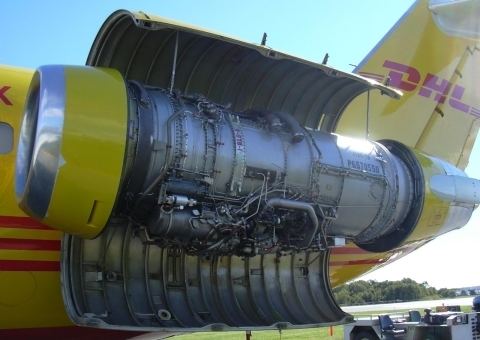 | ||
The Pratt & Whitney JT8D is a low-bypass (0.96 to 1) turbofan engine, introduced by Pratt & Whitney in February 1963 with the inaugural flight of the Boeing 727. It was a modification of the Pratt & Whitney J52 turbojet engine, which powered the US Navy A-6 Intruder attack aircraft. The Volvo RM8 is an afterburning version that was license-built in Sweden for the Saab 37 Viggen fighter. Pratt & Whitney also sells static versions for powerplant and ship propulsion as the FT8.
Contents
Design
The JT8D is an axial-flow front turbofan engine incorporating dual-spool design. There are two coaxially-mounted independent rotating assemblies: one rotating assembly for the low pressure compressor (LPC) which consists of the first six stages (i.e. six pairs of rotating and stator blades, including the first two stages which are for the bypass turbofan), driven by the second (downstream) turbine (which consists of three stages); and a second rotating assembly for the high-pressure compressor (HPC) section, which has seven stages. The high-pressure compressor is driven by the first (upstream) turbine, which has a single stage.
The front-mounted bypass fan has two stages. The annular discharge duct for the bypass fan runs along the full length of the engine, so that both the fan air and exhaust gases can exit through the same nozzle. This arrangement allows some noise attenuation, in that the still-hot fast-moving turbine exhaust is shrouded in much-cooler and slower-moving air (from the bypass fan) before interacting with ambient air. Thus the JT8D noise levels were significantly reduced from previous non-turbofan engines, although the low bypass ratio meant that, compared to subsequently developed turbofans, high noise levels were still produced.
Eight models comprise the JT8D standard engine family, covering the thrust range from 12,250 to 17,400 pounds-force (62 to 77 kN) and power 727, 737-100/200, and DC-9 aircraft. More than 14,000 JT8D engines have been produced, totaling more than one-half billion hours of service with more than 350 operators making it the most popular of all low-bypass turbofan engines ever produced.
Within the fan inlet case, there are anti-icing air bosses and probes to sense the inlet pressure and temperature. Similar units exist throughout the engine to check temperatures and pressures.
At the 13th (i.e. the final) compressor stage, air is bled out and used for anti-icing. The amount is controlled by the Pressure Ratio Bleed Control sense signal (PRBC). The diffuser case at the aft end of the compressor houses the 13th stage. Its increasing cross-sectional area allows the compressed air to slow down before entering one of the engine's nine burner cans. Again, there are two bosses to extract 13th stage air for anti-icing, de-icing of fuel, and airframe (cabin pressurization) use. Not all the compressed air enters the burner cans at the fuel-ignition point; some bypasses the can completely and cools the first turbine stage, and some is gradually introduced into the burner can's perimeter in such a way that the burning fuel is held near the can's centerline.
There are nine combustion chambers positioned in a can-annular arrangement. Each chamber has three air inlet hole sizes: the smallest is for cooling, the medium is for burning and the large for forming an air blanket.
Update programs
In response to environmental concerns that began in the 1970s, the company began developing a new version of the engine, the JT8D-200 series. Designed to be quieter, cleaner, more efficient, yet more powerful than earlier models, the -200 Series power-plant was re-engineered with a significantly higher bypass ratio (1.74 to 1) covering the 18,500 to 21,700 pound-force (82 to 97 kN) thrust range and powering the McDonnell Douglas MD-80 series. This increase was achieved by increasing bypass fan diameter from 39.9 inches (101 cm) to 49.2 inches (125 cm) and reducing fan pressure ratio (from 2.21 to 1.92). Overall engine pressure ratio was also increased from 15.4 to 21.0. Since entering service in 1980, more than 2,900 of the -200 series engines have been produced.
The JT8D-217 and -219 engine(s) were tested in 2001 and were deemed suitable replacements for the old TF33 engines on military and commercial aircraft as part of the Super 27 re-engining program. The updated engines offer reduced (Stage-3) noise compliance standards without the need for hush kits, enhanced short field performance, steeper and faster climb rates with roughly a 10% reduction in fuel burn for extended range.
Pratt & Whitney, in a joint venture with Seven Q Seven (SQS) and Omega Air, has developed the JT8D-219 as a re-engine powerplant for Boeing 707-based aircraft. Northrop Grumman used the -219 to re-engine one of the United States Air Force’s fleet of 19 Joint Surveillance Target Attack Radar System (E-8 Joint STARS) aircraft, which will allow the JSTARS more time on station due to the engine's 17% greater fuel efficiency. NATO also plans to re-engine their fleet of E-3 Sentry AWACS aircraft. The -219 is publicized as being half the cost of the competing 707 re-engine powerplant, the CFM-56, for reasons of geometrical and balance similarity to the engine it is replacing and the associated relative up-front wing modification costs of the two choices.
The proposed Aerion SBJ supersonic business jet, previously under development, was to use a pair of JT8D-219 engines for sustained supersonic flight.
Variants
Ratings are Normal Takeoff (Max. 5 min.).
Applications
Accidents
Specifications (JT8D-219)
Data from PW
